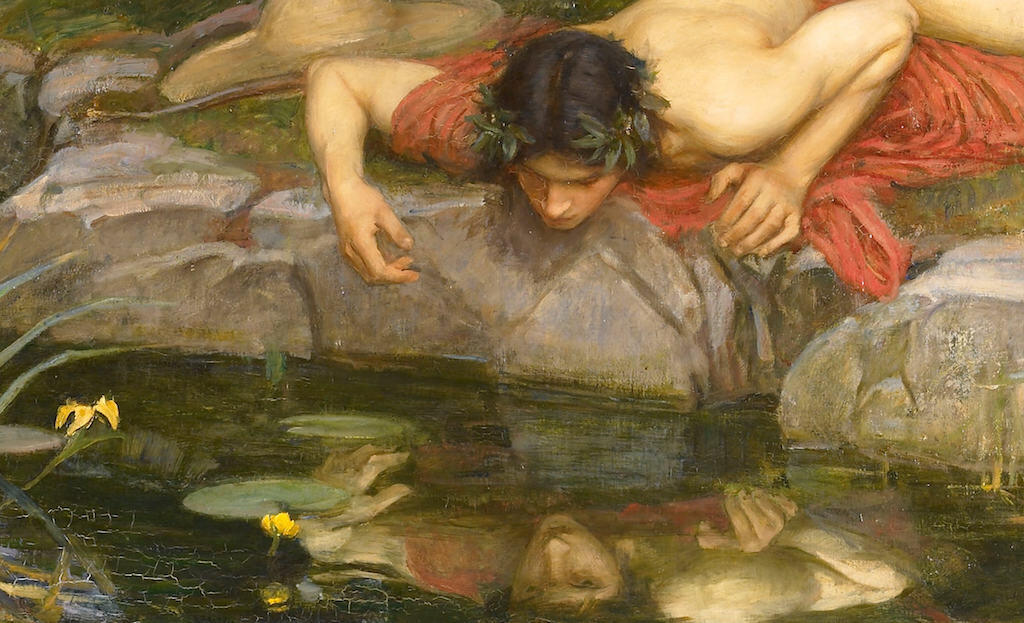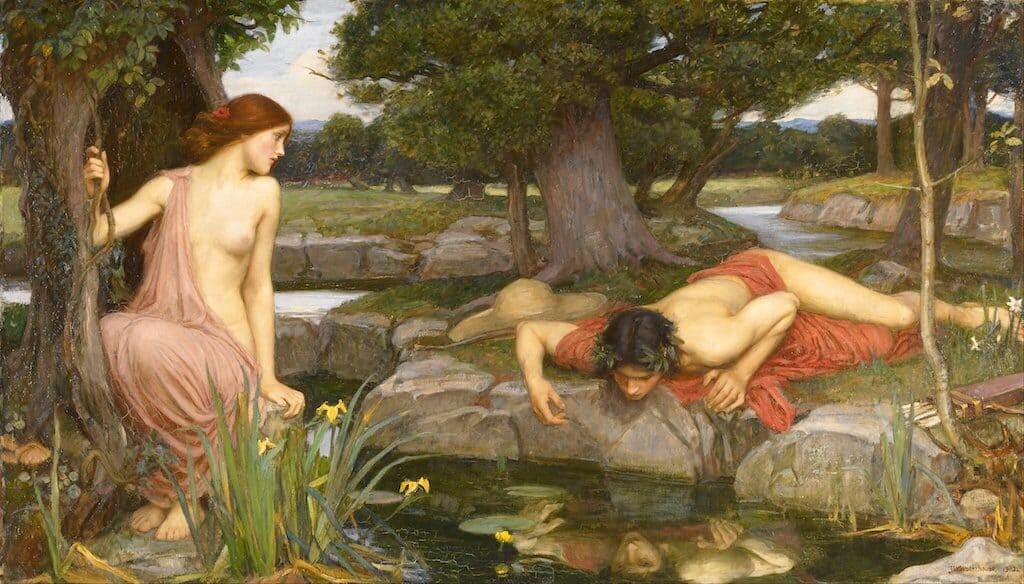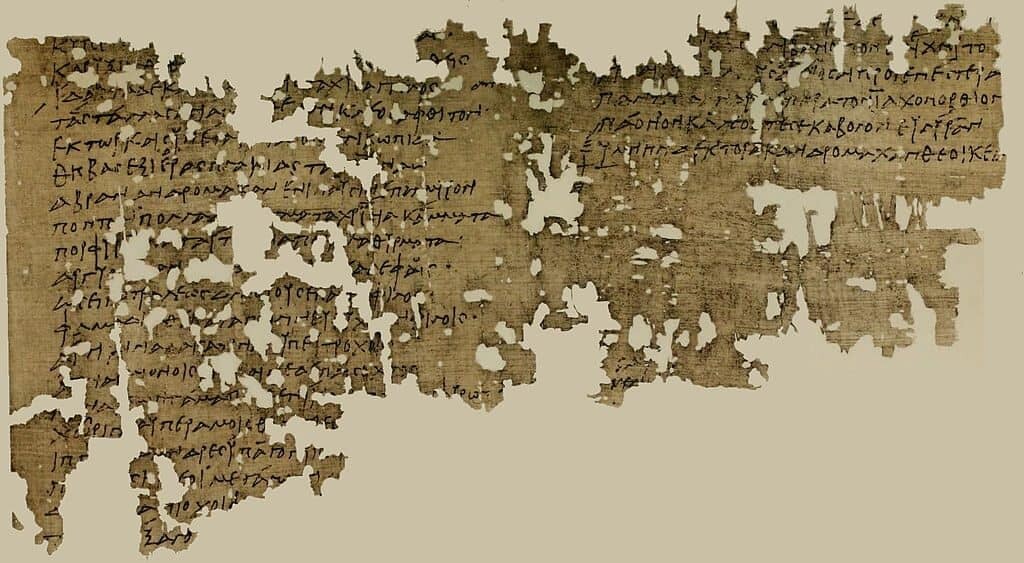Of the great legion of characters in Greek mythology, Narcissus has earned the most distinctive role in our modern-day vernacular. Remember the boy who tragically fell in love with himself? Today, we frequently hear the terms Narciss-ist and Narciss-ism. Both pertain to a condition in the Diagnostic and Statistical Manual of Mental Disorders (DSM) and derive from the human nature of the Greek character, himself. The roots of the Narcissus myth go back thousands of years. Indeed, the earliest written works that we know of were created in the 1st century BCE. However, not all the stories about the self-centered boy were the same. Who were those early poets and how did their versions differ?

Ovid
Ironically, one of the most well-known versions of this famous Greek poem was written by a poet who was not Greek, but Roman. Ovid was born east of the city of Rome around 43 BCE and lived until 16 or 17 CE during the reign of Augustus. In his early life as a teenage man, Ovid decided to become a poet and began putting his pen to parchment. He also traveled to a number of Greek areas that included Asia Minor and Athens. Around the year 2 CE, he began writing Metamorphoses, which is comprised of 15 books that contain about 250 myths. In book 3, Ovid gives us the longest version of Narcissus, as follows.
Echo and Narcissus
In Ovid’s story of Narcissus, Cephisus, the river-god, forces the gorgeous nymph Liriope into coitus under the waves. She gets pregnant by him and gives birth to a beautiful child that she names Narcissus. Liriope consults the seer Tiresias and asks him if her son will live to full age. The prophet replies with “If he does not discover himself.”
Many years go by, and Narcissus grows into a stunning 16-year-old boy. Many suitors, both male and female, have attempted to capture his heart, but he rejected all of them out of pride. One day the mountain nymph Echo spots Narcissus while he’s hunting deer in the woods. She is consumed by the boy’s beauty. Instantly, she falls madly in love with him, and she secretly tracks his every step as he moves through the woods.
The Lake Without Birds: Mythology, Oracles, and Gods
Although Echo wants to approach Narcissus to profess her desires for him, she cannot because she suffers from a severe speech impediment that was forced upon her as a curse by Juno (or Hera), the wife of Zeus. It was a fact that Zeus loved to philander with the nymphs, and this made Juno very jealous. Each time, just when Juno was about to catch the nymphs having relations with Zeus, Echo would distract her with verbose conversation to give the nymphs time to escape Juno’s wrath. The jealous goddess punished Echo by taking away her ability to communicate, and now she can only say the last few words that are spoken to her. Thus, Echo cannot express herself to Narcissus, so she waits for him to say something first so that she may at least repeat his words.
The Meeting
As it happened, Narcissus becomes separated from his hunting companions and calls out, “Is anyone here?” Of course, Echo is there, and she calls back, “Here.” Narcissus wants to know who is there, and after a few verbal exchanges and echoed replies, Narcissus encourages the source of the voice to come out of hiding. She emerges and immediately throws her arms around his neck. However, instead of responding lovingly, the boy rejects Echo saying, “Away with these encircling hands! May I die before what’s mine [his body] is yours. She answers, ‘What’s mine is yours!” (Metamorphoses Book III).

Echo is embarrassed and flees in shame. The scorned nymph is so forlorn that she veils herself among the leaves and lives out her days in the mountain caves alone. All the while, her love continues to grow, as does her despair. Her body withers away and her bones turn into stones. Henceforth, only Echo’s voice remains in the mountains.
After the encounter with Echo, Narcissus continues to reject many others who are eager for the boy’s attention. One of his suitors becomes so scornful, he curses Narcissus that he may suffer the way he has made others suffer. Nemesis, the goddess who delivers vengeance for acts of arrogance, hears the plea.
The Curse
One day while hunting, Narcissus comes across an untouched, glassy spring. He is drawn to its beauty and lies down to take a drink, but what he sees in the still water enchants him. He is in love with what he sees and is inflamed by the features of the vision: the hair, his eyes, porcelain skin, and rosy cheeks. Attempts to kiss and hold the reflection are in vain, and Narcissus is only frustrated by the teasing reactions of the image. When Narcissus winks, the image winks back, when Narcissus waves, the image waves, and when he cries tears, he sees that the image also cries. Narcissus cannot understand why he cannot reach what he so desperately desires.
The tormented boy agonizes over his unrequited love. He cannot leave the spring and is trapped in his frozen gaze at his reflection, pining away for the boy in the water who rejects all advances. Then Narcissus realizes that the image is his, but it’s too late, as he has already fallen tragically in love with himself. Knowing that he can never have what he desires, his body withers away in despair. When Narcissus says “Goodbye” to the reflection, Echo’s voice says “Goodbye.” At that moment, Narcissus dies while peering into the spring.
When the nymphs go to the spring to collect Narcissus’ body for a proper funeral, what they find in the place where his body once lay is a white-petaled flower with a yellow center.
In the end, the prophecy of Tiresias came true. The beautiful boy did discover himself – in the form of his own reflection – and that discovery prevented him from living beyond his youth.
Conon
The Greek mythographer, Conon, who lived sometime around the late first century BCE to the early first century CE, also wrote of Narcissus – possibly before Ovid. Indeed, some scholars believe that Ovid’s and Conon’s accounts derive from the same older Greek source, however, that source is a mystery (Nelson:370).
Conon’s story tells of a boy by the name of Narcissos (Narcissus) who grew up in a city called Thespeia in ancient Greece’s central region of Boiotia. His version is similar to Ovid’s in that Narcissus was exceedingly beautiful and disdained all of his suitors. As punishment by the gods, he falls tragically in love with his own reflection. However, three major differences exist between Ovid’s and Conon’s stories.
First, Conon names the spurned lover who cursed Narcissus. It was Ameinias, a fragile young man who pursued the youthful boy only to be rejected repeatedly. When Ameinias does not give up, Narcissus sends a sword to him suggesting to Ameinias that he kill himself. Ameinias goes to Narcissus’ home and appears on his doorstep. After praying earnestly to the gods to take revenge on Narcissus, he takes Narcissus’ sword and kills himself.
The second major difference between the stories is how Narcissus dies. At the spring, he falls in love with himself in both versions. However, according to Conon, in the end, Narcissus’ despair over his self-love and his belief that he suffered justly for his harsh treatment of Ameinias leads him to takes his own life (Dickinson College). His blood runs onto the earth causing the narcissus flower to grow. (Some interpretations say that he also felt remorseful and, thus, took his life.)
Lastly, of the early sources of the Narcissus myth, Ovid’s version is the only one that mentions Echo (quite extensively) and any female suitors.
Pausanias
An alternative, yet brief, version of the Narcissus myth comes from the Greek traveler and writer, Pausanias (110 CE – 180 CE). He wrote Descriptions of Greece in which he discusses the common story of how the youth falls in love with his own reflection in the spring. However, Pausanias expresses his disbelief of how a young man old enough to fall in love could be so ridiculously naive as to not know the difference between a real man and his own reflection.
Pausanias references a story that is a lesser-known, but still credible (according to Pausanias), account of the Narcissus myth. In this version, Narcissus had a twin sister. She looked and dressed exactly like him, and they spent much time together hunting in the forests. Narcissus was deeply in love with her, but she died tragically. To ease his suffering, he would frequent the spring to peer at the reflection that reminded him of his sister, all the while knowing it was only his own image that he saw.
Here is a quote regarding the entirely different version of the Narcissus myth from the Perseus Project’s translation of Descriptions of Greece, book 9, chapter 31:
[blockquote align=”none” author=”Pausanias”]The story goes on that Narcissus fell in love with his sister, and when the girl died, would go to the spring, knowing that it was his reflection that he saw, but in spite of this knowledge finding some relief for his love in imagining that he saw, not his own reflection, but the likeness of his sister.[/blockquote]
Parthenius
In the late 1800s, two men discovered an ancient garbage pile containing thousands of papyri documents in Oxyrhynchus, Egypt. Translations of the documents have been underway since 1898, and in 2005, what appears to be remnants of a papyrus containing mythological stories was published. On one side of that papyrus, someone had written down the Narcissus myth in the form of a poem that experts attribute to the Greek poet, Parthenius of Nicaea (Turkey).
See also: Oxyrhynchus Papyri: Historical Treasure in Ancient Egyptian Garbage

Although the papyrus is in fragments, the following is a translation (from the Oxyrhynchus Online) of what researchers were able to piece together. Dots indicate missing words or uncertainty in the letters.
… god-like …
… …
He had a cruel heart, and hated all of them,
Till he conceived a love for his own form:
He wailed, seeing his face, delightful as a dream,
Within a spring; he wept for his beauty.
Then the boy shed his blood and give it to the earth
… to bear
As in Conon’s prose version, this poem depicts Narcissus killing himself and his blood spilling on the ground.
If this poem is indeed the work of Parthenius, it may be the oldest story of Narcissus we know of. It appears that Parthenius’ birth date is not known. However, it is known that around 73 or 72 BCE, he was captured and taken to Rome. Recall that Ovid also lived near Rome. Later, Parthenius continued to live his life in Italy and eventually died in Rome in 14 CE. Experts estimate that his poem may originate from about 50 BCE.
How Old is the Narcissus Myth?
The first person to write down the Narcissus myth is a mystery. “The earliest known versions of these myths date back more than 2,700 years, appearing in written form in the works of the Greek poets Homer and Hesiod. But some of these myths are much older. Indeed, the Greeks borrowed some of their best material from other, more ancient stories” (American Museum of Natural History). Therefore, it is possible that the Narcissus myth existed in the Greek oral tradition well before poets took to pen.
You may also like: The Trojan War Myth: Fact or Fiction of Homer’s The Illiad